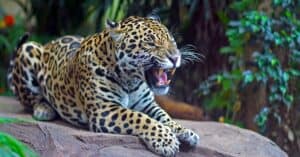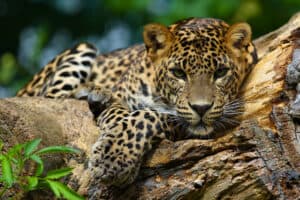
Have you ever wondered if the magnificent and elusive jaguar roams the wilds of Texas? In this article, we discover the size of the largest jaguar ever caught in Texas. We also explore the fascinating history, background, habitat, diet, hunting techniques, and conservation efforts of jaguars in the Lone Star State.
Jaguars once roamed vast territories, from the southern United States to the far reaches of South America. Over time, their range has contracted due to habitat loss, hunting, and human encroachment. Yet, despite the challenges they face, these majestic creatures continue to captivate our imagination and remind us of the wild beauty that still exists on our planet.
What Is the Largest Jaguar Ever Caught in Texas?
The largest jaguar ever caught in Texas scored an impressive 17 2/16 points. Hunter A. D. Attwater caught the cat in Mills, Texas, on January 1, 1903. The Boone & Crockett Club recorded the jaguar’s skull’s length as 10 6/16 inches and the width as 6 12/16inches. The National Museum of Natural History currently owns the prized trophy.
Where is Mills, Texas, Located on a Map?
Mills, Texas, is a small town located in the central part of the state. Despite its size, Mills has a rich history and culture that draws visitors from near and far. The town is situated in an agricultural region known for its productive farms and ranches, which contribute to the local economy.
If you’re looking for directions to Mills, it’s important to note that the town doesn’t have a major highway or airport nearby. However, there are several smaller roads that lead into Mills from surrounding towns and cities. Some of these routes may be more scenic than others, so it’s worth taking your time to explore them if you have the chance.
One popular way to get to Mills is by driving along Highway 84 East toward Waco. From there, take State Route 6 South until you reach County Road 1020 East (also known as Elm Creek Road). Follow this road for about five miles until you see signs indicating the entrance to Mills.
Another option is to take Interstate 35 North towards Dallas/Fort Worth and then exit onto Highway 77 North towards Hillsboro. Once you reach Milford, turn left onto FM-308/Cedar Hill Street and follow this road until you reach County Road 1050 West (also known as Mill Creek Road). Turn right here and continue on until you arrive at Mills.
No matter how you choose to get there, one thing is certain: once you arrive in Mills, Texas, you’ll find yourself surrounded by friendly locals.
The Largest Jaguar Ever Caught in the World
The largest jaguar on record was a male weighing over 328 lbs. To provide context, this impressive size is comparable to a defensive lineman on the NFL’s Jacksonville Jaguars team. Typically, male jaguars weigh 110-220 lbs., while females, being approximately 20% smaller, range from 75-175 lbs. For comparison, male Florida panthers weigh 100-155 lbs., and their female counterparts 65-100 lbs.
Background on Jaguars
Before we delve into the specifics of jaguars in Texas, let’s take a moment to familiarize ourselves with these awe-inspiring big cats. Known for their beauty, strength, and agility, jaguars are the largest wild cats in the Americas and the third largest globally, trailing only behind lions and tigers.
Physical Characteristics
Jaguars are powerfully built, with muscular bodies and strong limbs designed for climbing, swimming, and leaping. In addition, their distinctive golden-yellow coat is adorned with dark rosette-shaped markings, which provide excellent camouflage in their natural environment.
Some jaguars, known as melanistic or black jaguars, have an increased presence of dark pigment, giving them a predominantly black coat. Despite their dark fur, the rosette patterns are still faintly visible.
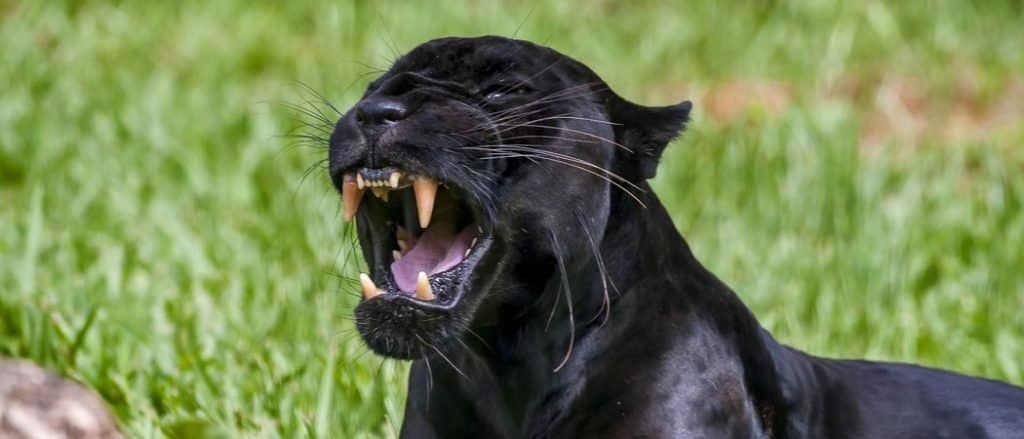
Some jaguars, known as melanistic or black jaguars, have an increased presence of dark pigment, giving them a predominantly black coat.
©Leonardo Mercon/Shutterstock.com
The Role of Jaguars in the Ecosystem
As apex predators, jaguars have a significant impact on the ecosystems they inhabit. Their presence helps maintain the balance of their environment, ensuring a healthy and diverse ecosystem.
- Apex predators are at the top of the food chain. Jaguars sit at the top of the food chain in their ecosystems. That means they have few if any, natural predators. However, they’re critical in controlling the populations of other species, particularly herbivores. By keeping these populations in check, jaguars help prevent overgrazing and promote the growth of diverse vegetation.
- Impact on prey populations. Jaguars’ predation not only helps regulate prey populations but also influences the behavior of their prey. For example, herbivores may avoid areas where jaguars are known to hunt. This can help reduce overgrazing and promote plant diversity. Ultimately, the presence of jaguars in an ecosystem contributes to a complex web of interactions that maintain ecological balance and biodiversity.
Historical Presence of Jaguars in Texas
Before delving into the current status of jaguars in Texas, it’s important to understand their historical presence in the region. Jaguars were once prevalent throughout Lone Star State, serving as vital components of the local ecosystems.
Tracing the Footsteps of Jaguars in Pre-European Times
Let’s take a walk back in time to the era before Europeans arrived in Texas. During this period, jaguars roamed freely across the region, sharing their home with Native American tribes. The presence of jaguars in the area helped shape the natural landscape and the cultural heritage of the indigenous people.
Native American tribes in Texas, such as the Apache, Comanche, and Karankawa, had a deep respect and admiration for jaguars. These majestic animals are often featured in tribal stories, myths, and spiritual practices, symbolizing strength, stealth, and grace. The presence of jaguars in the region created a powerful connection between the tribes and the natural world around them.
In pre-colonial times, jaguars thrived in various habitats across Texas, from the dense forests in the east to the arid deserts in the west. They roamed vast territories, coexisting with other large predators like wolves and bears. As apex predators, jaguars helped maintain the balance of the ecosystems they inhabited.
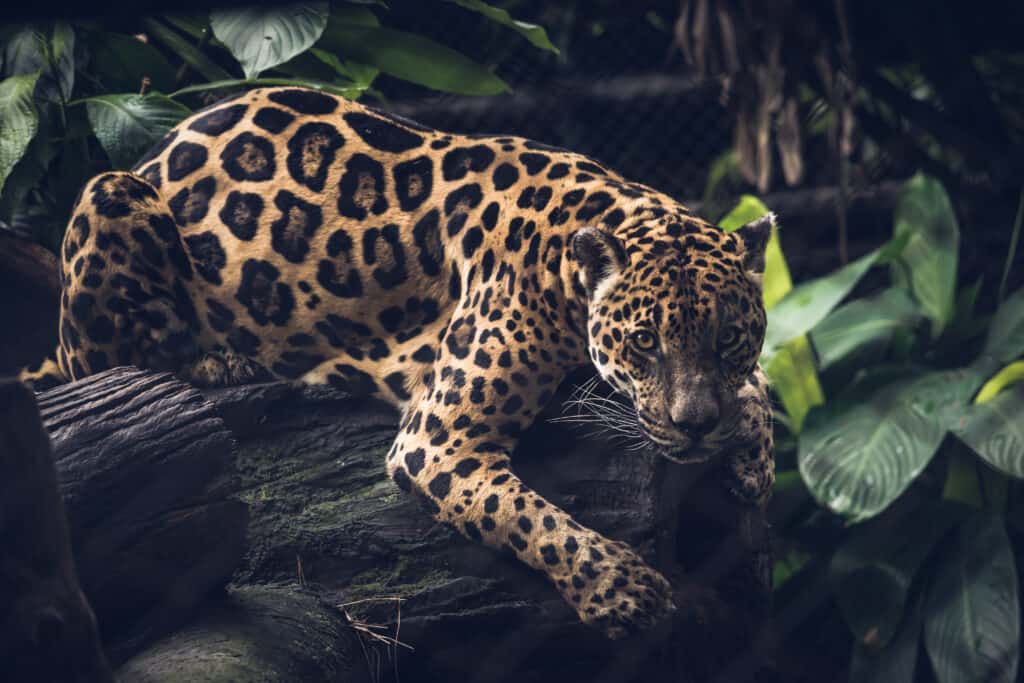
The Jaguar is a large and muscular animal that has a heavier and sturdier body than that of a
Leopard
.
©George Arenas/Shutterstock.com
The Changing Landscape: Post-European Contact
The arrival of Europeans in Texas marked a turning point for jaguars in the region. As settlers established new communities and expanded their territories, the habitat of the jaguar began to shrink, and their population experienced a sharp decline. As a result, the once abundant big cat became a rare sight in the vast landscapes of Texas.
As settlers built farms, ranches, and towns, the jaguar’s natural habitat became increasingly fragmented. Forests were cleared, and rivers were dammed, forcing jaguars to retreat into smaller, disconnected territories. This habitat loss led to a decline in prey populations, further endangering the survival of the jaguar in Texas.
In addition to habitat loss, jaguars also faced threats from hunting. Settlers often considered jaguars a menace to their livestock and hunted them to protect their herds. Additionally, the allure of their beautiful fur and the thrill of hunting a powerful predator led to trophy hunting, further contributing to the jaguar’s decline in Texas.
Habitat and Range
To fully appreciate the jaguars’ presence in Texas and their role in the ecosystem, it’s essential to understand their habitat and range. These adaptable felines inhabit diverse environments, from dense rainforests to arid scrublands.
The Jaguar’s Natural Home
Jaguars are highly adaptable creatures, capable of thriving in various environments. From lush tropical forests to arid grasslands, these elusive cats have carved out a home in some of the most diverse habitats across the Americas. So let’s take a closer look at where these majestic felines prefer to roam.
- Tropical and subtropical forests. Jaguars have a particular affinity for dense forests, where their distinctive coat patterns provide the perfect camouflage for stealthy hunting. In addition, tropical and subtropical forests offer plenty of cover and an abundance of prey. This makes them ideal habitats for these skilled predators. Jaguars are commonly found in the Amazon Basin, the Pantanal, and the dense rainforests of Central America.
- Wetlands and grasslands. In addition to forests, jaguars can also be found in wetlands and grasslands. These environments offer unique challenges and opportunities for the adaptable big cats. For example, in wetlands, jaguars take advantage of their strong swimming abilities to hunt aquatic prey such as caimans and turtles. Grasslands, on the other hand, provide ample space for the cats to stalk and ambush their prey.
The Expansive Territory of the Jaguar
The historical range of the jaguar spans an impressive expanse of North and South America. Over the centuries, however, their territory has contracted, leaving jaguars with a fraction of their original domain.
- Distribution in North and South America. Historically, jaguars roamed from the southern U.S. all the way down to Argentina, encompassing a vast array of ecosystems. Today, their range has significantly diminished, primarily due to habitat loss, hunting, and human encroachment. The largest populations of jaguars are now concentrated in the Amazon Basin and the Pantanal wetlands in South America.
- Range contraction and fragmentation. As human populations have grown and expanded, the jaguar’s territory has become increasingly fragmented. Forests have been cleared for agriculture and urban development, wetlands have been drained, and grasslands have been converted to farmland. These changes have led to isolated pockets of suitable habitat, making it challenging for jaguars to maintain healthy, interconnected populations.
Diet and Hunting Techniques
The jaguar is an awe-inspiring predator renowned for its adaptability and hunting expertise. However, to truly comprehend the role of jaguars in their ecosystems, including those in Texas, it’s crucial to examine their dietary preferences and the techniques they employ to secure their prey.
The Varied Palate of the Jaguar
As we venture deeper into the world of jaguars, it’s essential to explore their dietary preferences and the hunting techniques they employ to secure their next meal. Jaguars are opportunistic predators, which means they consume a diverse array of prey to satisfy their nutritional needs. So let’s take a closer look at the Jaguar’s menu.
- Mammals and other animals. Jaguars have a preference for medium to large-sized mammals, such as deer, tapirs, and peccaries. But their diet isn’t limited to these creatures. Jaguars are known to hunt and consume over 85 different species, including reptiles, birds, and fish. This varied diet allows them to adapt to different environments and take advantage of the available food sources.
- Opportunistic feeding behavior. As opportunistic feeders, jaguars are always on the lookout for their next meal. However, they’re not picky eaters and will consume carrion if fresh prey is scarce. This adaptability allows them to survive in changing environments and cope with fluctuations in prey populations.
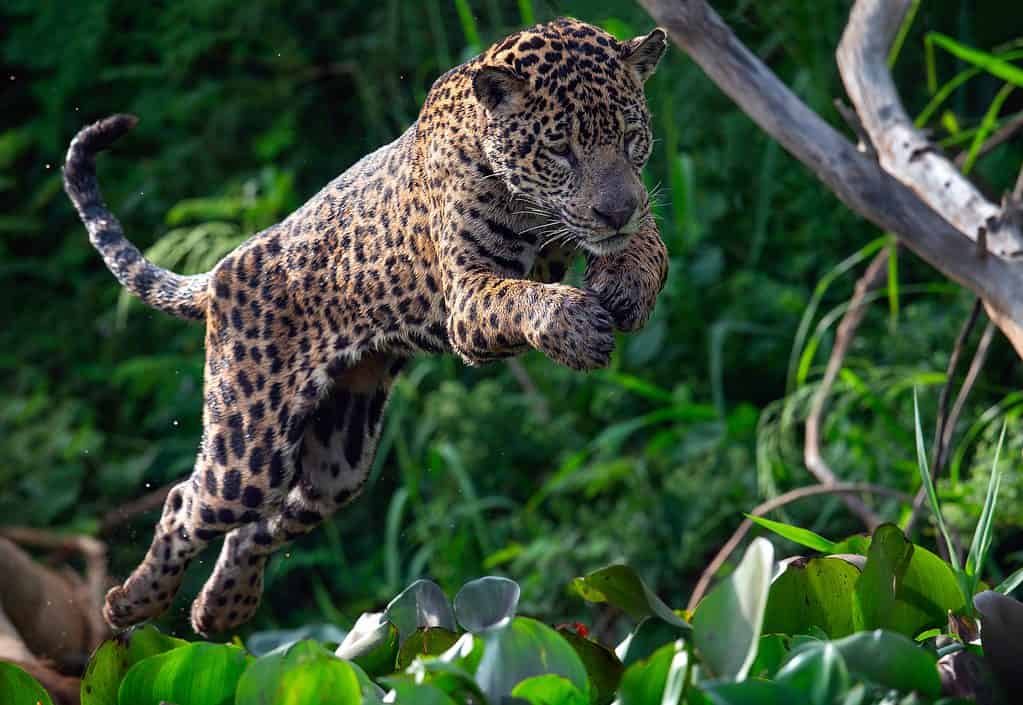
Jaguars move at high speeds and can reach up to 80 miles per hour.
©Sergey Uryadnikov/Shutterstock.com
Mastering the Art of the Hunt
Jaguars aren’t just impressive predators because of their varied diet; their hunting techniques are equally fascinating. These powerful cats are masters of stealth and ambush, using their physical prowess and keen senses to secure their prey.
- Ambush and stealth tactics. Jaguars excel in the art of ambush. They rely on their excellent camouflage to blend into their surroundings, patiently waiting for their prey to venture within striking distance. Once the opportune moment arrives, they pounce, using their powerful limbs to tackle their prey and deliver a swift, lethal bite.
- Adaptations for efficient hunting. Jaguars possess several adaptations that make them efficient hunters. Their powerful jaws and sharp teeth are designed to deliver a crushing bite to their prey’s skull, severing the spinal cord and causing instant death. In addition, their muscular build and strong limbs allow them to climb trees, swim, and leap great distances. This makes them versatile predators capable of capturing a wide range of prey.
Current Status of Jaguars in Texas
Having explored the jaguars’ historical presence, habitat, and hunting prowess, it’s now time to focus on their current status in Texas. Over the years, the jaguar population in the Lone Star State has faced various challenges, leading to a decline in their numbers.
The Elusive Texan Jaguar: A Rare Sight
With their historical presence in Texas well-established, it’s time to examine the current status of jaguars in the Lone Star State. Over the years, jaguars have become an increasingly rare sight in Texas, with only a handful of confirmed sightings in recent decades.
The decline of jaguars in Texas can be attributed to several factors, including habitat loss, hunting, and human encroachment. As mentioned earlier, the expansion of human settlements, agriculture, and urban development has fragmented the jaguar’s natural habitat. This has made it difficult for these solitary animals to maintain their populations. In addition, hunting, both for trophy and livestock protection, has also played a role in the jaguar’s diminishing presence in Texas.
Despite their scarcity, jaguars have not entirely disappeared from Texas. In recent years, there have been a few confirmed sightings and instances of photographic evidence, primarily in the southern and western parts of the state. These sightings provide a glimmer of hope that jaguars may still be present in Texas, albeit in small, isolated populations.
The Potential for Jaguar Recovery in Texas
As we ponder the future of jaguars in Texas, it’s important to consider the potential for recovery and the factors that could support or hinder their resurgence in the region.
Habitat connectivity is critical to the recovery of jaguars in Texas. Establishing wildlife corridors and protected areas that connect isolated populations can help facilitate gene flow, ensuring the long-term survival of these elusive cats. Cross-border cooperation with Mexico, where jaguars still maintain a more substantial presence, is also essential for supporting the re-establishment of jaguars in Texas.
Key Takeaways
As we reach the end of our thrilling journey exploring jaguars in Texas, we’ve learned about their captivating history, preferred habitats, and the unique challenges they face. It’s clear that jaguars hold a special place in our hearts. As such, their story in Texas is far from over. Understanding the role jaguars play in the ecosystem and their potential to enrich the biodiversity of Texas is crucial.
The photo featured at the top of this post is © en: User: Cburnett, CC BY-SA 3.0, via Wikimedia Commons – License / Original
Thank you for reading! Have some feedback for us? Contact the AZ Animals editorial team.




